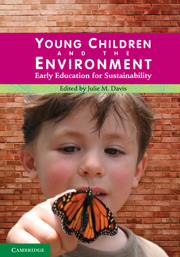Book contents
- Frontmatter
- Foreword
- Contents
- List of contributors
- Introduction
- PART 1
- Chapter 1 What is early childhood education for sustainability?
- Chapter 2 Children in the natural world
- Chapter 3 Leadership for creating cultures of sustainability
- Chapter 4 Practical possibilities and pedagogical approaches for early childhood education for sustainability
- Chapter 5 Ethics and pedagogy at the heart of early childhood education for sustainability
- PART 2
- Endnote
- Index
- References
Chapter 4 - Practical possibilities and pedagogical approaches for early childhood education for sustainability
from PART 1
- Frontmatter
- Foreword
- Contents
- List of contributors
- Introduction
- PART 1
- Chapter 1 What is early childhood education for sustainability?
- Chapter 2 Children in the natural world
- Chapter 3 Leadership for creating cultures of sustainability
- Chapter 4 Practical possibilities and pedagogical approaches for early childhood education for sustainability
- Chapter 5 Ethics and pedagogy at the heart of early childhood education for sustainability
- PART 2
- Endnote
- Index
- References
Summary
EDITOR'S NOTE
In this chapter, Robert Pratt, a highly experienced early childhood teacher and advocate for ECEfS, discusses his personal approach to EfS. He shares just a small part of this extensive repertoire of day-to-day teaching ideas and strategies that made his work at Campus Kindergarten so successful and acclaimed. These include: gardening projects; waste-minimisation practices, including composting and litterless lunches; water and energy saving strategies; green cleaning; and ways to engage children in learning about complex sustainability issues and topics.
At the heart of Robert's approach is his commitment to the health and integrity of natural environments and to children's right to a sustainable future. As you will see, Robert has built his curriculum on a perspective of children as competent and capable learners who are well able to solve problems and take actions to deal with environmental and sustainability issues of relevance to their lives.
INTRODUCTION
The goal of education for sustainability is to empower children and adults to think and act in ways that meet their immediate needs without jeopardising the potential of future generations to meet their own needs. A sustainable lifestyle promotes intergenerational responsibility and equity, ensuring that future generations enjoy an undiminished quality of life. Sustainable practice at the early childhood level is not about a few ad hoc outdoor experiences with plants and animals, but a holistic approach that integrates all aspects of sustainability into early childhood services.
(Elliott & Young, 2006)- Type
- Chapter
- Information
- Young Children and the EnvironmentEarly Education for Sustainability, pp. 104 - 153Publisher: Cambridge University PressPrint publication year: 2010
References
- 4
- Cited by



